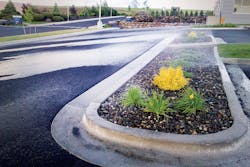Combination Conservation
A month after Schweitzer Engineering Laboratories (SEL) completed the construction of its new Zocholl research facility in Pullman, Wash., one of its landscape technicians noticed a problem: Excess water was on the sidewalks, in the parking lot and in several places in front of the new building.
SEL Landscape Technician Dennis Ollgaard had an idea of how much water the new Zocholl building should be using, but he knew the amount of water consumed could change periodically due to changes in the weather, increases in landscaping activities, or changes in the habits or number of building occupants. Because the building had just been constructed, data on historic water usage had not yet been collected. Ollgaard could estimate how much water might be needed, but a clear usage pattern was not yet available for comparison.
Fortunately, the problem was easy to see and not due to a break in a line in an obscure location. If the water had not been pooling all over the sidewalks and the street, this problem might have persisted for some time, but Ollgaard knew there was another way to view what was happening.
Software Capabilities
As part of the Zocholl building’s construction, SEL had included its own advanced metering and revenue system. The SEL-735 is an electric power meter that provides advanced trending capabilities in addition to power quality (PQ) measurements. Although the meter cannot directly measure resources—such as water, air, gas, electricity and steam (WAGES)—it can count electrical pulses sent to it. For example, a pulse output device could send one electrical pulse for every gallon of water that passes through the utility water or gas meter.
The advanced metering system for the new Zocholl building consisted of two SEL-735 meters and was set up for campus-wide energy monitoring and optimization. The system monitors resource usage, including energy, water, gas and PQ disturbances.
The data showed that at night, the irrigation program was running twice as often as it should have been. This information allowed Ollgaard to immediately and confidently make a system correction that reduced daily water consumption by 32%, saving 4,000 gal of water per day.
“This meter system helps us know if we are using more water than we should be,” Ollgaard said. “With just the utility bill each month, it’s hard to know if the increase in water consumption is due to hotter days, a break that is not in sight or more landscaping.”
The advanced metering and revenue system also monitors multiple resources through a single interface. Because it collects pulses from WAGES meters, users can view trends for water, irrigation, gas and electrical consumption in a single report.
Pulse Output Devices
As part of the building’s construction, SEL asked its utility provider to supply pulse output devices from the utility’s gas and water meters. These devices were connected to the two meters at the Zocholl building.
The devices send pulses corresponding to a certain quantity passing through the meters. The main meter is set to scale the units by 0.1 to indicate that every electrical pulse represents 0.1 gal of water through the flowmeter. It counts pulses from the utility gas and water meters and determines the consumption trend over time using its internal recorders. The trending views can help identify water leaks, over-usage, time of use and more. In the case of combining gas and electric metering, the trended data can be used to optimize HVAC control systems to reduce peak electrical demands and identify any HVAC efficiency issues.
The advanced math, logic equations and trending capabilities of the meter enable it to count pulses from almost any legacy device. Data can be exported as a report or communicated via industry-standard protocols.
With a close look at the data, a company’s accounting department can accurately allocate costs to each area of the company. Short-term monitoring and spot measurements provide information about equipment performance, loading and instantaneous consumption, while long-term data are used for energy management and to assess the impact of projects.
For site-wide data visualization from all meters on campus, SEL uses ACSELERATOR Meter Reports SEL-5630 software. Data from the meters are periodically sent to a common database where they are queried for reports. The software allows users to customize reports, perform addition and subtraction of metering points, and analyze events, all through a single interface.
By submetering each of its buildings and monitoring WAGES, SEL can create accountability at the process or departmental level with almost minute-by-minute data acquisition on resource consumption and trends.
From simple problems like the excess water usage at the Zocholl building to more complex problems such as determining campus-wide WAGES, the metering system is useful for keeping track of resources and getting to root causes of problems. Having the system integrated into the Zocholl building’s design will help SEL quickly troubleshoot a variety of scenarios far into the building’s lifespan.
The WAGES metering capabilities supply the necessary data to make strategic decisions that save additional costs and resources. Resources saved by system improvement and problem solving ultimately free up additional financial resources for the company as a whole. Furthermore, with data from meters across the SEL campus, facilities can manage energy usage and optimize operations to shift peak demands. Years of data storage also provide the ability to analyze the impact of energy efficiency measures, which can drive further energy optimization.
